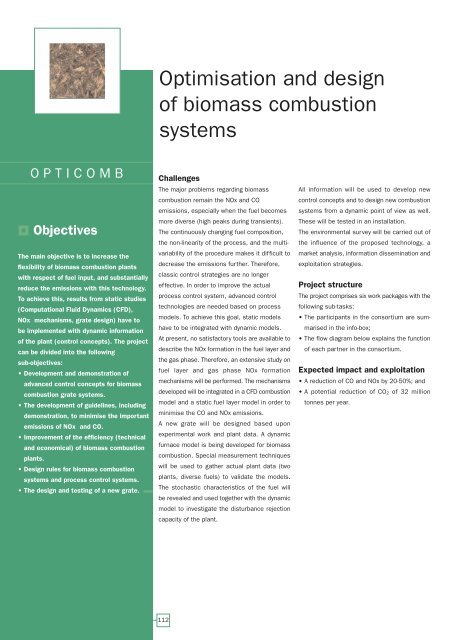European Bio-Energy Projects
European Bio-Energy Projects
European Bio-Energy Projects
You also want an ePaper? Increase the reach of your titles
YUMPU automatically turns print PDFs into web optimized ePapers that Google loves.
OPTICOMB<br />
Objectives<br />
The main objective is to increase the<br />
flexibility of biomass combustion plants<br />
with respect of fuel input, and substantially<br />
reduce the emissions with this technology.<br />
To achieve this, results from static studies<br />
(Computational Fluid Dynamics (CFD),<br />
NOx mechanisms, grate design) have to<br />
be implemented with dynamic information<br />
of the plant (control concepts). The project<br />
can be divided into the following<br />
sub-objectives:<br />
• Development and demonstration of<br />
advanced control concepts for biomass<br />
combustion grate systems.<br />
• The development of guidelines, including<br />
demonstration, to minimise the important<br />
emissions of NOx and CO.<br />
• Improvement of the efficiency (technical<br />
and economical) of biomass combustion<br />
plants.<br />
• Design rules for biomass combustion<br />
systems and process control systems.<br />
• The design and testing of a new grate.<br />
Optimisation and design<br />
of biomass combustion<br />
systems<br />
Challenges<br />
The major problems regarding biomass<br />
combustion remain the NOx and CO<br />
emissions, especially when the fuel becomes<br />
more diverse (high peaks during transients).<br />
The continuously changing fuel composition,<br />
the non-linearity of the process, and the multivariability<br />
of the procedure makes it difficult to<br />
decrease the emissions further. Therefore,<br />
classic control strategies are no longer<br />
effective. In order to improve the actual<br />
process control system, advanced control<br />
technologies are needed based on process<br />
models. To achieve this goal, static models<br />
have to be integrated with dynamic models.<br />
At present, no satisfactory tools are available to<br />
describe the NOx formation in the fuel layer and<br />
the gas phase. Therefore, an extensive study on<br />
fuel layer and gas phase NOx formation<br />
mechanisms will be performed. The mechanisms<br />
developed will be integrated in a CFD combustion<br />
model and a static fuel layer model in order to<br />
minimise the CO and NOx emissions.<br />
A new grate will be designed based upon<br />
experimental work and plant data. A dynamic<br />
furnace model is being developed for biomass<br />
combustion. Special measurement techniques<br />
will be used to gather actual plant data (two<br />
plants, diverse fuels) to validate the models.<br />
The stochastic characteristics of the fuel will<br />
be revealed and used together with the dynamic<br />
model to investigate the disturbance rejection<br />
capacity of the plant.<br />
112<br />
All information will be used to develop new<br />
control concepts and to design new combustion<br />
systems from a dynamic point of view as well.<br />
These will be tested in an installation.<br />
The environmental survey will be carried out of<br />
the influence of the proposed technology, a<br />
market analysis, information dissemination and<br />
exploitation strategies.<br />
Project structure<br />
The project comprises six work packages with the<br />
following sub-tasks:<br />
• The participants in the consortium are summarised<br />
in the info-box;<br />
• The flow diagram below explains the function<br />
of each partner in the consortium.<br />
Expected impact and exploitation<br />
• A reduction of CO and NOx by 20-50%; and<br />
• A potential reduction of CO2 of 32 million<br />
tonnes per year.

















